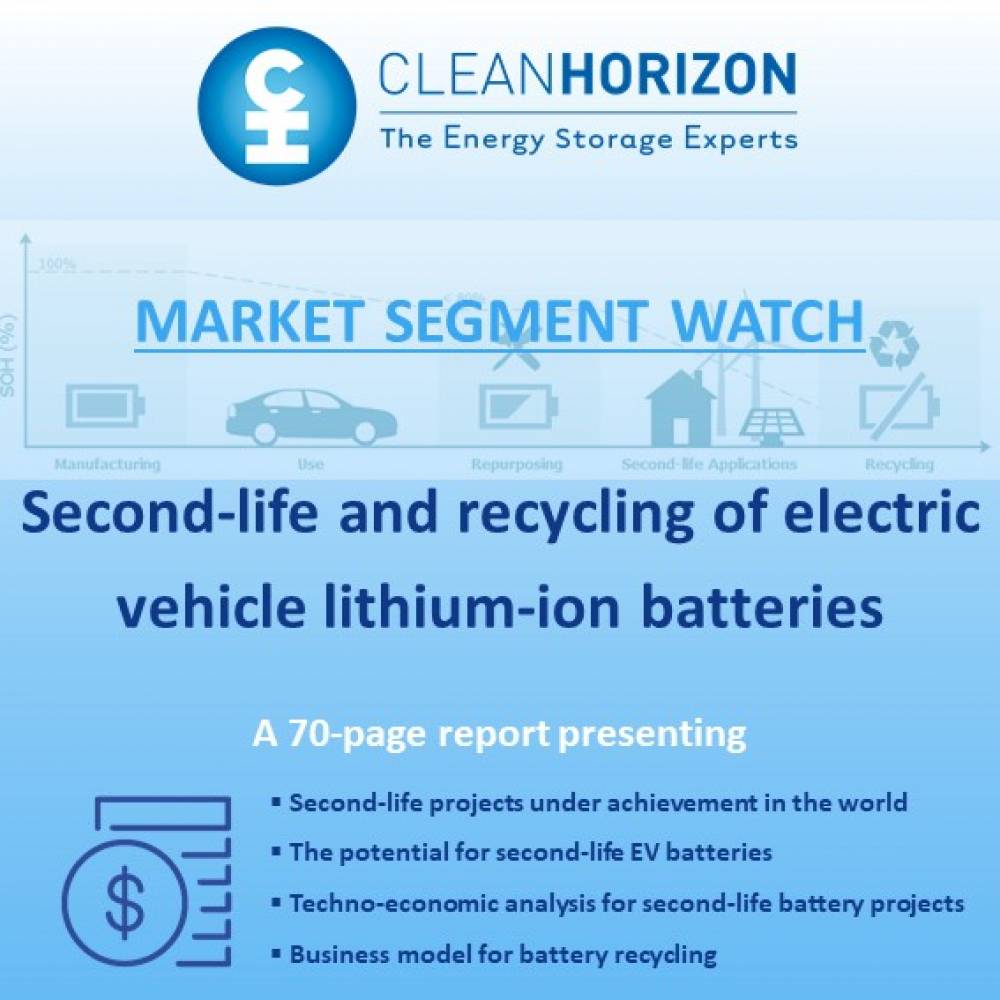Market Segment Watch Second-life and recycling of electric vehicle lithium-ion batteries 2019
2500 €
A market analysis highlighting the key takeaways on Second-life applications and recycling of li-ion batteries from electric vehicles, which may represent a potential of over 200 GWh by 2030.
Description
TABLE OF CONTENTS
Executive summary (2)
Table of figures (6)
Introduction (7)
Production of lithium-ion batteries – increase in volume (7)
EV uptake and the demand for energetically dense batteries (7)
Chemistries of lithium-ion batteries (9)
Economic and environmental concerns for “end of life” EV batteries (15)
Lifetime of lithium-ion batteries in EVs (17)
Recycling of lithium-ion batteries (18)
Policy concerning recycling (19)
Metals of interest (21)
Material Volumes (26)
Methods of recycling lithium-ion batteries (28)
Economics of battery recycling (32)
Recycling Companies and Actors (36)
Concerns with collection, transportation, and hoarding (37)
Second-life applications (38)
Rationale for second-life applications (40)
Current methods and obstacles (41)
Pricing and availability (45)
Market potential for EV second-life batteries (45)
Environmental impacts of second-life battery projects (48)
Current and future projects concerning second-life applications (50)
Conclusions (58)
TABLE OF FIGURES
Figure 1. Uptake of EV sales and vehicle OEMs (8)
Figure 2. Worldwide electric vehicle stock (2013 - 2017) (9)
Figure 3. Cross section of a lithium-ion battery with typical anode and cathode chemistries (10)
Figure 4. The different battery chemistries used in various EVs (14)
Figure 5. Typical EV battery metal content (kg/kWh) (14)
Figure 6. Concept of circular economy for EV batteries (16)
Figure 7. Material and metal demand for lithium-ion battery packs for passenger electric vehicles (21)
Figure 8. Material demand from electric vehicle sector in terms of total world demand (2016 and 2021 forecast) (22)
Figure 9. Cost breakdown of an NMC 1-1-1 cell (22)
Figure 10. Estimated potential recovery volumes of materials in NMC batteries (27)
Figure 11. Advantages and drawbacks of the pyrometallurgical recycling method (29)
Figure 12. Pyrometallurgical physical recycling process (29)
Figure 13. Advantages and drawbacks of the hydrometallurgical recycling method (30)
Figure 14. Chemical treatment: Hydrometallurgical recycling process (30)
Figure 15. Advantages and drawbacks of the mixed recycling method (31)
Figure 16. Intermediate physical recycling process (31)
Figure 17. Advantages and drawbacks of the direct physical recycling method (32)
Figure 18. Direct physical recycling process (32)
Figure 19. Mass repartition of lithium-ion NMC 1-1-1 EV battery (33)
Figure 20. Potential revenue streams for recycling metals in NMC And NCA batteries (October 2018) (34)
Figure 21. Potential revenues from recycling Co, Ni, and Cu (90% recovery yield) from NMC batteries depending on their cathode composition (35)
Figure 22. Actors in lithium-ion and NiMH battery recycling by method (37)
Figure 23. Lithium-ion battery recycling capacities of current recycling actors (38)
Figure 24. Estimated volumes for second-life applications (in GWh) (40)
Figure 25. Proposed guide for EV battery use based on SOH (derived from Canal Casals and Garcia) (42)
Figure 26. Typical options for second-life battery repurposing (43)
Figure 27. Required annual revenues for three second-life battery scenarios in comparison with a new battery and typical energy market revenues per year (47)
Figure 28. Levelized Cost of Storage based on battery price and cycles/year for second-life and new batteries (48)
Figure 29. Estimated CO2 footprint from manufacturing and mobility for diesel vehicle and an EV (charged using different electricity mixes) (51)
Figure 30. Potential “avoided” CO2 emissions from second-life EV project compared to a new battery and diesel vehicle use ( battery manufacturing CO2 NOT included) (52)
Figure 31. Map of second-life EV battery projects and MWh by country (54)
